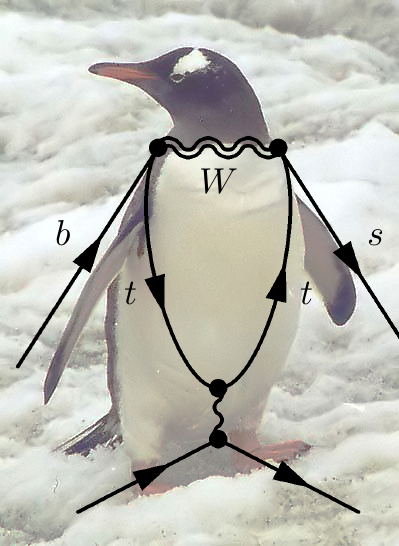Thomas Jones
About Me
I started my studies at Warwick in 2019 and I am a current Ph.D. student in the LHCb group. Before Warwick, I studied an undergraduate degree in physics with particle physics and cosmology at Lancaster University. As part of my undergraduate degree I completed a masters project with the particle physics group in Lancaster, which involved the study of the capabilities of the upcoming neutrino detector - Hyper-Kamiokande.
Current Research and Motivation
Many particle physics experiments are looking for ways to find evidence for new particles that are not predicted by the standard model of particle physics. These particles could be produced in high energy collisions at the LHC. The new particles could also affect lower energy processes. New particles, in the form of virtual particles, could have an effect on b hadron decays that occur via loop level Feynman diagrams.
FCNC (Flavour Changing Neutral Current) decays involving quark transitions can only occur at loop level (see penguin diagram below) in the standard model and are rare. Due to the small size of the Standard Model contribution, new physics contributions to these decays could provide a large identifiable effect. As such, studies of these decays provide highly sensitive tests of new physics beyond the standard model.
My research involves the study of rare FCNC (Flavour Changing Neutral Current) baryon decays in the LHCb experiment. In recent years the semi-leptonic decays of a B meson to a strange meson and a pair of oppositely charged leptons like
, has undergone significant study. The
baryon can provide complementary information to these B meson decays. Currently, the only
decay that has been studied in detail is
[1]. In addition to this, the LHCb experiment has performed a search for CP violation in the decay
[2]. My research aims to perform a more detailed study of the
decay.

Feynman diagram showing a b -> s quark transition. Also known as a penguin diagram. Taken from https://en.wikipedia.org/wiki/Penguin_diagram
TORCH
Measurements of the rely heavily on the positive particle identification of protons and kaons. In the current LHCb detector, this is possible for kaon momentum over 10 GeV/c and proton momentum at a minimum of 15 GeV/c. These thresholds are quite high and the sensitivity to decays such as
could be improved with particle identification at lower momenta. One proposed idea to solve this is the inclusion of the TORCH detector. The main function of the TORCH detector is to exploit time-of-flight measurements for charged particles by the precise timing of the Cherenkov photons emitted in a quartz radiator bar. My Ph.D. involves work on the speed-up of the reconstruction algorithm that will be used in TORCH. I also plan on getting involved in studies on some hardware that may be used in the TORCH. This is planned to go ahead during my long term attachment stay at CERN in 2022.
Undergraduate Teaching
I mark and demonstrate the gamma ray spectroscopy experiment in the second year undergraduate lab module: PX271.
References
[1] Descotes-Genon, S., Matias, J. and Virto, J., 2013. Understanding the B→K*μ+μ−anomaly. Physical Review D, 88(7). https://arxiv.org/abs/1307.5683
[2] LHCb Collaboration., 2017. Observation of the decay Λ b 0 → pK − μ + μ − and a search for CP violation. Journal of High Energy Physics, 2017(6). https://arxiv.org/abs/1703.00256

Contact Details
Office:
P449
Email:
tom dot p dot jones at warwick dot ac dot uk
thomas dot peter dot jones at cern dot ch
Address:
Department of Physics, University of Warwick, Coventry, CV4 7AL
